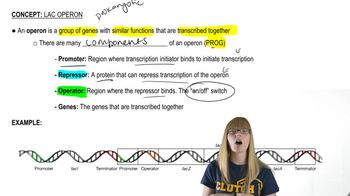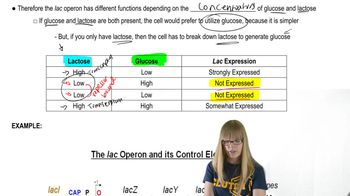Table of contents
- 1. Introduction to Genetics51m
- 2. Mendel's Laws of Inheritance3h 37m
- 3. Extensions to Mendelian Inheritance2h 41m
- 4. Genetic Mapping and Linkage2h 28m
- 5. Genetics of Bacteria and Viruses1h 21m
- 6. Chromosomal Variation1h 48m
- 7. DNA and Chromosome Structure56m
- 8. DNA Replication1h 10m
- 9. Mitosis and Meiosis1h 34m
- 10. Transcription1h 0m
- 11. Translation58m
- 12. Gene Regulation in Prokaryotes1h 19m
- 13. Gene Regulation in Eukaryotes44m
- 14. Genetic Control of Development44m
- 15. Genomes and Genomics1h 50m
- 16. Transposable Elements47m
- 17. Mutation, Repair, and Recombination1h 6m
- 18. Molecular Genetic Tools19m
- 19. Cancer Genetics29m
- 20. Quantitative Genetics1h 26m
- 21. Population Genetics50m
- 22. Evolutionary Genetics29m
12. Gene Regulation in Prokaryotes
Lac Operon
Problem 4
Textbook Question
Contrast the role of the repressor in an inducible system and in a repressible system.
 Verified step by step guidance
Verified step by step guidance1
Understand the basic definitions: An inducible system is one where the presence of a specific molecule (inducer) activates gene expression, while a repressible system is one where the presence of a specific molecule (corepressor) inhibits gene expression.
In an inducible system, the repressor protein is initially bound to the operator region of the DNA, preventing transcription. The presence of an inducer molecule binds to the repressor, causing a conformational change that releases the repressor from the operator, allowing transcription to proceed.
In a repressible system, the repressor protein is initially inactive and cannot bind to the operator. The presence of a corepressor molecule binds to the repressor, activating it. The active repressor-corepressor complex then binds to the operator, blocking transcription.
Compare the mechanisms: In an inducible system, the repressor is inactivated by the inducer, leading to gene expression. In a repressible system, the repressor is activated by the corepressor, leading to gene repression.
Consider the biological significance: Inducible systems often respond to environmental changes, such as the presence of a substrate that needs to be metabolized, while repressible systems often regulate the synthesis of end products, preventing overproduction.
 Verified video answer for a similar problem:
Verified video answer for a similar problem:This video solution was recommended by our tutors as helpful for the problem above
Video duration:
2mPlay a video:
Was this helpful?
Key Concepts
Here are the essential concepts you must grasp in order to answer the question correctly.
Inducible Systems
Inducible systems are regulatory mechanisms in which a repressor protein inhibits gene expression until an inducer molecule binds to the repressor. This binding causes a conformational change, allowing the transcription of the gene to proceed. A classic example is the lac operon in E. coli, where the presence of lactose induces the expression of genes necessary for its metabolism.
Recommended video:
Guided course

Induced Mutations
Repressible Systems
Repressible systems function oppositely to inducible systems, where the repressor is inactive until a corepressor molecule binds to it. This binding activates the repressor, which then attaches to the operator region of the gene, blocking transcription. An example is the trp operon, which is repressed in the presence of tryptophan, preventing the synthesis of enzymes involved in its production.
Recommended video:
Guided course

Sex Determination
Repressor Proteins
Repressor proteins are crucial components of gene regulation, acting to inhibit transcription by binding to specific DNA sequences. In inducible systems, they prevent gene expression until an inducer is present, while in repressible systems, they require a corepressor to become active. Understanding the function of these proteins is essential for grasping how cells control gene expression in response to environmental changes.
Recommended video:
Guided course

Proteins

 4:27m
4:27mWatch next
Master Lac Operon Overview with a bite sized video explanation from Kylia Goodner
Start learning



